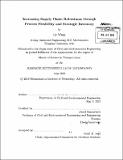Increasing supply chain robustness through process flexibility and strategic inventory
Author(s)
Wang, He, Ph. D. Massachusetts Institute of Technology
DownloadFull printable version (2.965Mb)
Other Contributors
Massachusetts Institute of Technology. Department of Civil and Environmental Engineering.
Advisor
David Simchi-Levi.
Terms of use
Metadata
Show full item recordAbstract
When a disruption brings down one of company's manufacturing facilities, it can have a ripple effect on the entire supply chain and threaten the company's ability to compete. In this thesis, we develop an effective disruption mitigation strategy by using both process flexibility and strategic inventory. The model is focused on a manufacturer with multiple plants producing multiple products, where strategic inventory can be held for any product. We propose a new metric of supply chain robustness, defined as the maximum time that no customer demand is lost regardless of which plant is disrupted. Using this metric, we analyze K-chain flexibility designs in which each plant is capable of producing exactly K products. It is demonstrated that a 2-chain design, which is known to be effective for matching supply with demand when there is no disruption, is not robust when there is both disruption and demand uncertainty. However, it is shown that a 3-chain design is significantly more robust and achieves the same robustness as full flexibility under high uncertainty level. We then extend the model to an assembly system and find that investment in process flexibility designs changes the optimal inventory placements. In particular, when the degree of flexibility is high, more inventory is allocated to standard components, i.e. components used by multiple products, but when the degree of flexibility is low, more inventory is allocated to non-standard components.
Description
Thesis (S.M. in Transportation)--Massachusetts Institute of Technology, Department of Civil and Environmental Engineering, 2013. Cataloged from PDF version of thesis. Includes bibliographical references (pages 73-75).
Date issued
2013Department
Massachusetts Institute of Technology. Department of Civil and Environmental EngineeringPublisher
Massachusetts Institute of Technology
Keywords
Civil and Environmental Engineering.